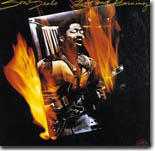 










 

Order this CD today
|

Son Seals
Live and Burning
Alligator Records

Way back in the
early 70’s, Bruce Iglauer was sweeping up at the Jazz Record Mart
one night when the phone rang. It was Wesley Race, one of Iglauer’s
friends and a huge fan of the blues, calling from the Flamingo Club
on the South Side of Chicago. When Iglauer picked up the phone,
Race told him to listen and turned the phone receiver toward the
bandstand. What Iglauer heard completely transformed his Alligator
Records label. The label was originally intended to be a one-shot
deal for Iglauer to record his favorite blues act, Hound Dog
Taylor. Hearing this new act eventually contributed to making
Alligator the most prominent, and prolific, blues label of the past
thirty years. The fiery lead guitar and raw, intense vocals Iglauer
heard belonged to Son Seals. Iglauer eventually recorded
Seals in 1973, which led to seven more releases on Alligator, and
Seals was hailed as one of the most original blues artists to emerge
in years.
No one asked me,
but if they did, my favorite live blues disc, bar none, of all time
would have to be 1978’s Live and Burning, Seals‘ third
Alligator release. The first time I popped this baby into my
cassette player 16 years ago, I knew it would be my favorite as long
as I had breath in my body. When I made the dreaded transition from
cassettes to CDs several years later, the first duplicate purchase
(owned on both cassette and CD) I made was Live and Burning
for the following reasons.
-
No live disc
captured the raw Chicago sound of the 70’s better. This disc
was recorded at the Wise Fools Pub, familiar stomping grounds
for the band, and there were likely lots of old friends
present. Seals’ guitar work is simply incredible and his vocals
are equally impressive. His enthusiasm is almost palpable, and
the intensity never lets up. Seals roars out of the gate with a
scorching cover of Elmore James’ “I Can’t Hold Out” and after
four minutes of pedal-to-the-metal guitar, he slows things down
for a simmering version of Lloyd Glenn’s “Blue Shadows
Falling”. Despite the tempo change, the energy level stays the
same. By the time he launches into “Funky Bitch” and “The Woman
I Love,” you know the audience had to have been hooked, because
you are hooked from just listening. Of the nine songs, six are
covers of mostly familiar songs, but you would never know it by
Seals’ vibrant delivery of each. They sound nothing like the
original versions.
-
The band,
featuring Lacy Gibson on second guitar, Snapper Mitchum doing
yeoman’s work on bass, drummer Tony Gooden (who would perish in
a train wreck during a European tour several years later), and
sax man extraordinaire A. C. Reed (augmented on one track by
Alberto Gianquinto on piano), is outstanding. If a well-oiled
machine played music, this is what it would sound like. These
guys played with Son for years and it’s obvious they knew each
other’s every move.
-
As the
listener, you actually feel like you’re part of the audience,
down to the obnoxiously loud fan who whoops it up between the
first two or three songs, complete with an off-key rebel yell
and cackling laughter. (Note: This is the guy who is usually
standing next to me at 85% of the shows or festivals I’ve ever
attended. Fortunately he can‘t be heard throughout the rest of
the set. Apparently the alcohol must have kicked in by then.)
During the proceedings, Son actually tells another fan to
stop bothering him. “Can’t you see I’m working up here?” He
growls to the delight of the audience. In fact, the audience
contributes to the sheer energy of the performance so much that
they should probably be listed as part of the band.
When the band rips
through “Hot Sauce” to close things out, you feel like you’ve been a
part of the whole thing. That’s what the best live discs in any
genre make you feel and Live and Burning fits the bill
perfectly. Seals would do other live discs (a hard-to-find set from
the 80’s on the old Blues R&B label is worth finding, and another
Alligator live set in the late 90‘s), but both paled in comparison
to Live and Burning, which captures a blues man at the top of
his game.
-- Graham Clarke
|


![]()